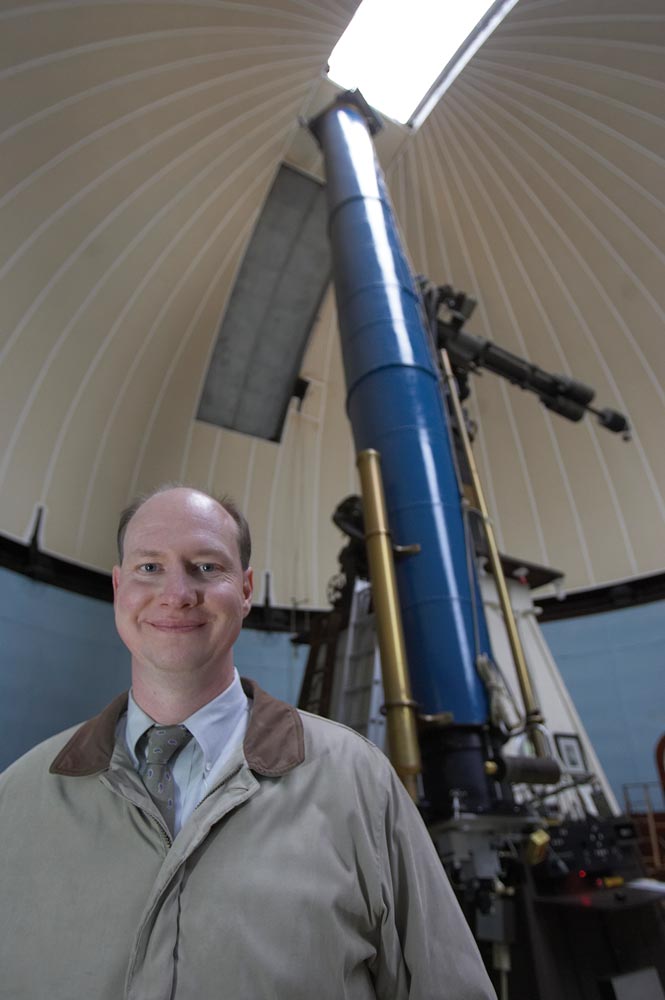We Are Stardust
Edward M. Murphy explains the ever-expanding field of astronomy

Astronomy professor Edward M. Murphy (Grad ‘93, ‘96) knows how the universe began. He also has a pretty good idea of how it will end, but he doesn’t appear to be worried. While he’s observing galaxies through the telescope at the McCormick Observatory with students or visitors, he reassures, “the night sky is not so mysterious. In fact, we know a great deal about it.” While the planets and stars capture popular attention, Murphy works to demystify the stuff between the stars. At Johns Hopkins University, he worked on the Far Ultraviolet Spectroscopic Explorer (FUSE), a telescope sent into space to measure the gas between stars. Why is he so interested in nearly empty space? “It’s important because it’s a record of what’s happened in the Milky Way in the past, and that gas will go on to form future generations of stars,” he says. “It’s the history of our Milky Way Galaxy written in the interstellar medium.”
Murphy’s course for first-years, Are We Alone? The Fermi Paradox, refers to the contradiction between the high likelihood of the existence of extraterrestrial life and the complete lack of evidence for it. In the next 15 years, Murphy expects to see research indicating that Earth-like planets are common in the universe. Although it may seem like a lofty expectation, Murphy insists it isn’t, because astronomy advances so rapidly.
“Fifteen years ago, we only knew of nine planets. We assumed other stars had planets going around them, but we had no way to detect them. Now, we’ve discovered more than 500 planets going around other stars.
“The universe as a whole is expanding,” says Murphy, “and not only that, but the rate of expansion is accelerating. There is no end to the universe. Our best research models indicate that it is infinite in extent, that it has no boundary and continues forever.”
Murphy’s Brief History of the Atom
Atoms are the basic unit of matter, constituting everything in the universe, from the stars in the night sky to our own fingertips. “Have you ever stopped to consider the origin of those atoms, the oxygen and carbon that make up your body?” asks Murphy. Atoms’ building blocks—protons, neutrons, and electrons—have existed since the birth of the universe, 13.7 billion years ago. But how did they get here?
Just after the Big Bang—a term that was coined sarcastically by cosmologist Fred Hoyle to describe the birth of the universe—atoms were all fairly simple. All that existed were light gases such as hydrogen, helium and lithium. Life as we know it—from amoebas to zebras—requires heavier, more complex atoms, which have not only more orbiting electrons but also more protons and neutrons inside their larger nuclei.
“As massive stars live out their lives, they fuse hydrogen atoms into helium atoms. Near the ends of their lives, they fuse helium to carbon, then carbon to oxygen, and then other reactions occur, synthesizing ever heavier elements until they reach iron,” says Murphy. Thus, these stars transform light elements into heavier elements such as the carbon in your DNA and the nitrogen and oxygen that you breathe.
Iron is the most stable element in the periodic table. Producing elements more massive than iron requires tremendous temperatures. A supernova—a giant imploding star—produces temperatures greater than 10 billion degrees. “In the few seconds that it takes a massive star to implode at the end of its life, all the elements heavier than iron are created,” says Murphy. The energy released in the implosion throws off the outer layers of the star, now enriched in these heavier elements.
About 4.6 billion years ago, in a little corner of the Milky Way, swirls of dust grains and gas began to coalesce into our solar system. A giant’s share became the sun—99.9 percent of atoms in our solar system are part of the sun. The small portion left behind included particles of dust and ice that kept colliding and fusing together over and over, creating the planets, asteroids and comets of our solar system.
Since the Big Bang, the atoms in your body have been inside multiple generations of stars. “The next breath you take will expel some of your atoms into the air, and these atoms will become part of something else, a raindrop or blade of grass,” says Murphy. As our sun dies, about 5 billion years from now, it will become a red giant star. The Earth will be heated such that the outer layers will evaporate off into space, and these atoms will again be in the interstellar medium. Eventually, these atoms will become part of another star. And on the cycle will go.